Science is fascinating, and you can share that excitement with your kids. Doing 10 fun science projects at home is a great way to bond and encourage their curiosity. You can even set up a kid-friendly science space using items you already have.
Science projects at home help your kids learn important skills like critical thinking. They can have fun exploring topics like kitchen chemistry and weather. These experiments are both fun and educational.
Key Takeaways
- You can create a kid-friendly science space at home to engage your kids in science activities
- Easy science experiments can be done using household items, making science accessible for kids
- Doing science projects at home can help your kids develop critical thinking and problem-solving skills
- You can explore various topics, such as kitchen chemistry and weather, using easy science experiments
- Engaging in science activities with your kids can promote their curiosity and love for science
- 10 fun science projects you can do at home can be a great way to spend quality time with your kids
- You can make science fun and educational for your kids with easy science experiments
Why Science Projects Are Essential for Your Child’s Development
Getting your child involved in diy science projects and other science activities is very important. It helps them think critically, be curious, and solve problems. These skills are key for success in life, and science projects make learning fun.
Some of the key benefits of science projects for kids include:
- Developing critical thinking skills through hands-on experiments and activities
- Fostering curiosity and creativity through open-ended questions and investigations
- Building problem-solving abilities through trial and error and experimentation
By adding diy science projects to your child’s learning, you lay a strong foundation for their future. Whether it’s simple home experiments or more complex projects, the benefits are huge. So, why not start today and see how science projects can help your child grow?
Science projects are more than just learning facts. They help your child understand the world better. By encouraging them to ask questions and explore, you foster a love for learning and set them up for success.
Safety First: Creating a Kid-Friendly Science Space
When it comes to educational science activities, safety is key. Setting up a science space at home means thinking about hazards. This helps make a safe place for your kids to explore and learn.
First, think about the experiments you’ll do and what you’ll need. Make a list of supplies and find a safe spot to store them. Important items include:
- Chemicals and substances
- Lab equipment, such as test tubes and beakers
- Safety gear, like goggles and gloves
Organizing your space and storing things right can prevent accidents. Always watch your kids during experiments. Teach them to follow safety rules. With some planning, you can make a safe space for learning.
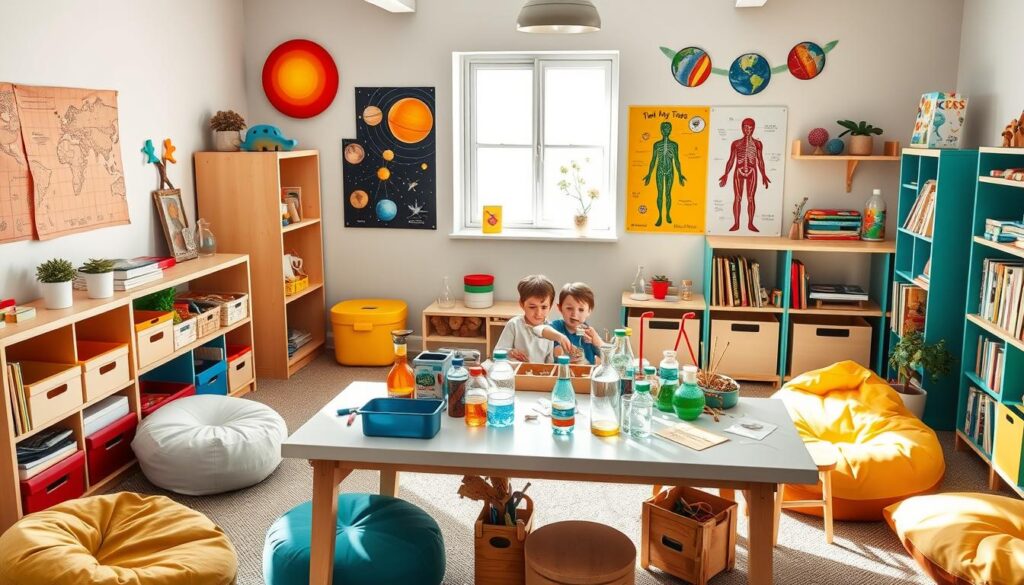
| Material | Safety Precaution |
|---|---|
| Chemicals | Store in a well-ventilated area, out of reach of children |
| Lab equipment | Handle with care, and ensure proper cleaning and storage |
| Safety gear | Use during experiments, and ensure proper fit and maintenance |
Essential Materials for Home Science Experiments
To start with hands-on science projects, you’ll need some basic materials. Many of these can be found in your home, making science fun and affordable. You can also reuse materials, which is good for the environment and boosts creativity.
Common Household Items You’ll Need
Common household items like baking soda, vinegar, and food coloring are great for science experiments. You can also use everyday objects like balloons, straws, and cardboard tubes. These items help create fun experiments, like homemade lava lamps and dancing raisins.
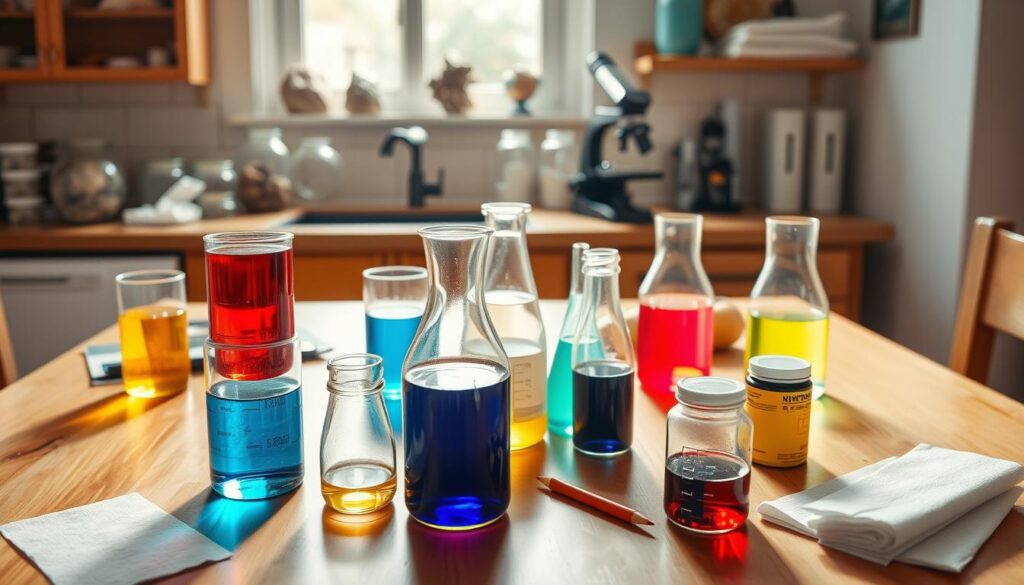
Basic Safety Equipment
It’s important to have basic safety equipment for science experiments. This includes goggles, gloves, and a lab coat. Also, keep a first aid kit nearby in case of accidents.
With these essential materials, you can create a safe and fun space for science projects. Always supervise children during experiments. Encourage them to ask questions and think critically.
10 Fun Science Projects You Can Do at Home Today
Get ready to spark your child’s curiosity with these engaging science experiments. They are easy to follow, safe, and fun for kids of all ages. You can create a homemade lava lamp, make slime, and conduct other exciting experiments. These will leave your kids amazed and eager to learn more.
Some of the projects you can try include:
- Creating a volcano using baking soda and vinegar
- Making a solar system using different materials
- Conducting a dance party with engaging science experiments using sound waves
These engaging science experiments are designed to be fun and educational. They allow your child to learn and explore the world of science in a hands-on way.
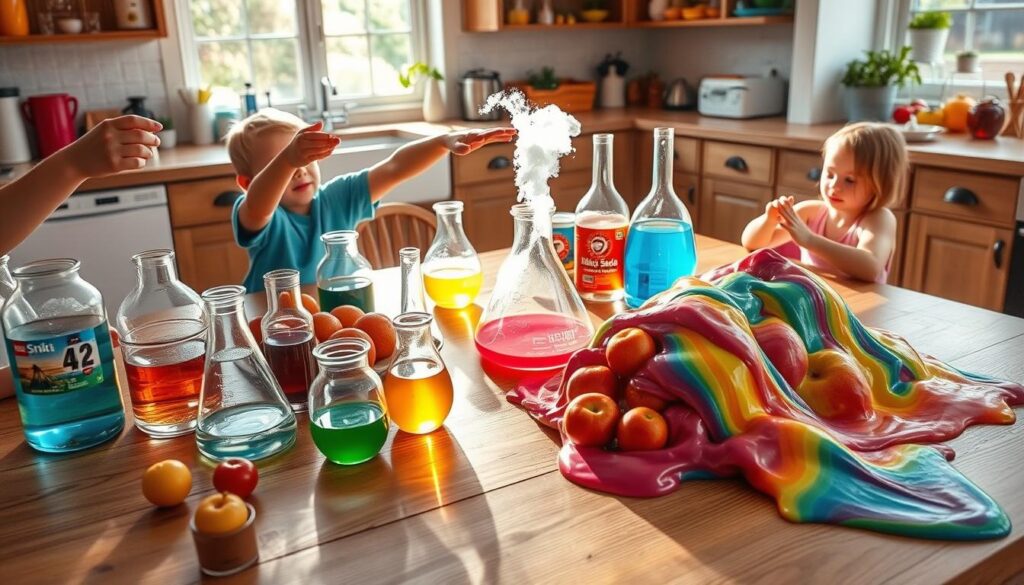
By trying out these projects, you’ll be encouraging your child to think critically, ask questions, and seek answers. All while having a blast with engaging science experiments.
Kitchen Chemistry: Experiments Using Everyday Ingredients
Ready to make your kitchen a science lab? These fun and easy experiments use common ingredients. They make learning both fun and tasty.
Color-Changing Milk Experience
To do this experiment, you need:
- milk
- food coloring
- soap
Add a few drops of food coloring to milk in a glass. Then, add a bit of soap. Watch as the milk changes color right before your eyes.
Homemade Lava Lamp
Make a lava lamp with vegetable oil, water, and food coloring. You’ll also need an Alka-Seltzer tablet for the fizz.
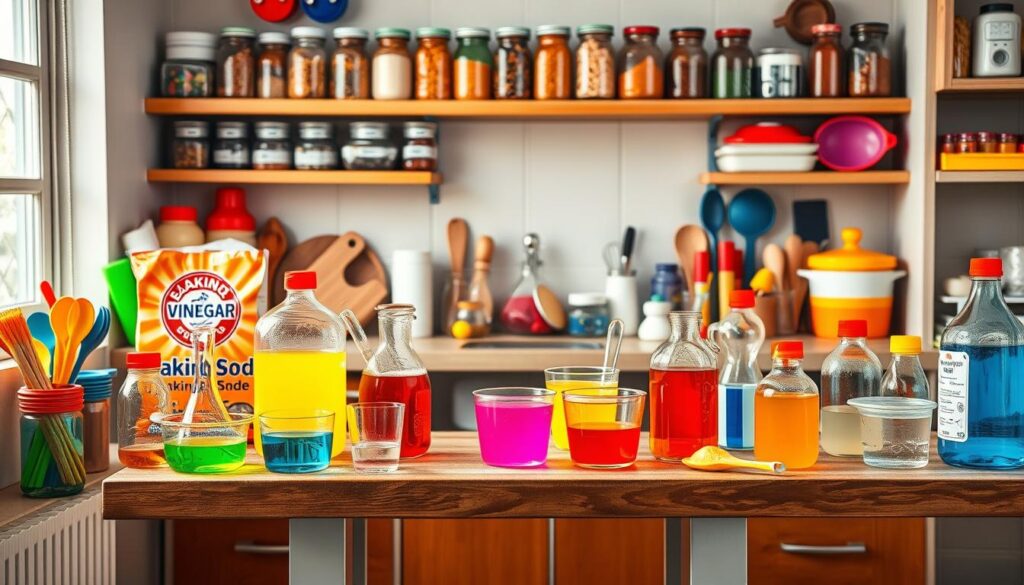
Dancing Raisins Experiment
Make raisins “dance” in a glass of soda. You’ll need:
- raisins
- soda
- a glass
Fill a glass with soda and add raisins. See how they react to the soda’s carbonation.
These science projects are great for both kids and adults. They use everyday items. So, why not start making your kitchen a science lab today?
| Experiment | Materials Needed |
|---|---|
| Color-Changing Milk Experience | milk, food coloring, soap |
| Homemade Lava Lamp | vegetable oil, water, food coloring, Alka-Seltzer tablet |
| Dancing Raisins Experiment | raisins, soda, glass |
Weather and Nature Projects for Young Scientists
As a parent, you can spark your child’s curiosity about nature with easy science experiments and diy science projects. These focus on weather and nature. They’re a fun way to learn about the environment and the science behind it.
Projects like creating a tornado in a bottle, making a solar oven, or studying erosion can be exciting. You can use simple materials to make these projects. This makes them easy and affordable.
Here are some diy science projects you can try with your child:
- Creating a homemade weather station to track temperature, humidity, and wind speed
- Making a terrarium to observe the water cycle and plant growth
- Conducting easy science experiments to show the effects of climate change

Trying these projects can help you and your child learn about nature. It also helps you appreciate the environment more. Always watch over your child during these activities. Encourage them to ask questions and think deeply about what they find.
Understanding Physical Science Through Play
Getting your kids involved in science projects can be a great way to help them learn about physical science. These activities can be both fun and educational, making learning a joy. Creating a kid-friendly science space at home is a good idea. It lets your children do experiments and explore science.
Some cool physical science projects you can try with your kids include:
- Creating a balloon static electricity experiment to show the power of static electricity
- Building simple machines using household items to learn about mechanics and motion
- Visualizing sound waves to understand the properties of sound and vibration
These activities are designed to be fun and interactive. They are perfect for science projects for kids. By doing these activities, you can help your kids develop a love for science and learning that will last a lifetime.
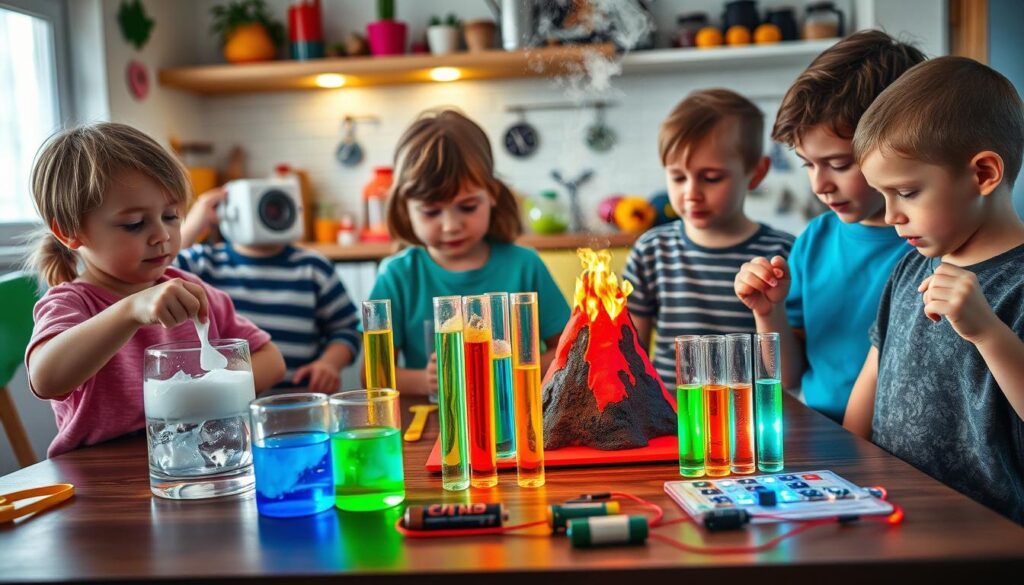
Always supervise your kids during these experiments. Encourage them to ask questions and think critically about the results. With a little creativity and imagination, you can turn your home into a science lab. This makes learning fun and exciting for your kids.
Making Science Projects Educational and Fun
To make learning fun for your kids, mix science projects with fun and interactive activities. Hands-on science projects help them understand science better. Using items from home makes it easy to show complex ideas in a simple way.
When doing science projects, it’s key to record observations and ask the right questions. This sparks curiosity and problem-solving skills. It also links experiments to everyday life, making learning fun and real.
- Encouraging curiosity and creativity through open-ended questions and experiments
- Developing problem-solving skills by using everyday materials and objects
- Connecting science projects to real-life situations, making learning more relevant and engaging
By following these tips, you can make learning fun and interactive. Always watch over your kids during experiments. This keeps them safe and encourages them to think and ask questions.
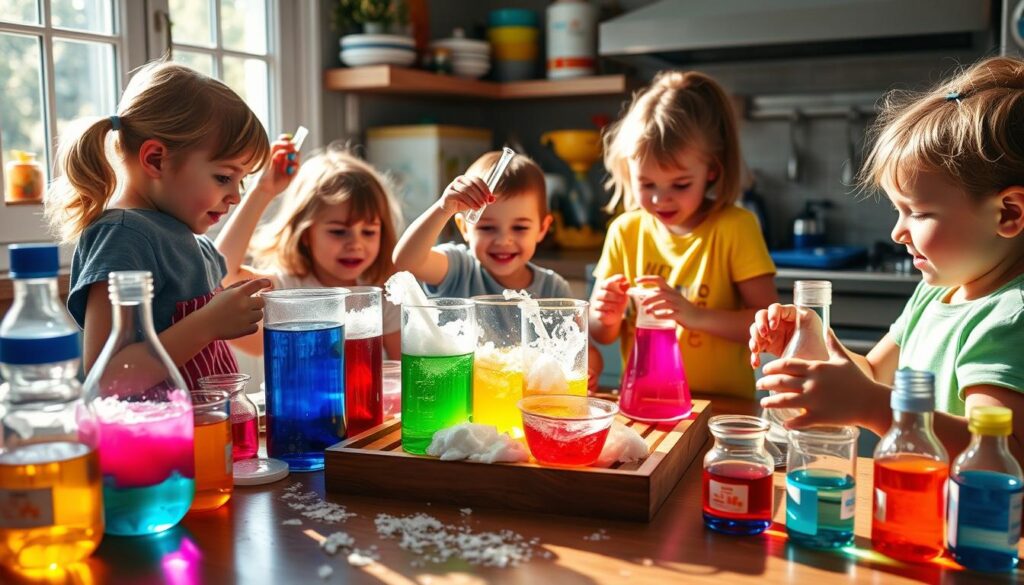
Conclusion: Nurturing Your Child’s Scientific Curiosity
Exploring these engaging science experiments and projects has shown you how to spark your child’s curiosity. By creating a supportive space for them to explore and learn, you’re helping them develop a love for science.
The journey of discovery is as important as the outcome. Encourage your child to observe, guess, and try new things. Celebrate their curiosity and help them see how science applies to everyday life.
These activities can light a spark that might lead to big scientific discoveries. Embrace the wonder and explore the unknown together. Watch as your child grows into a young researcher, ready to uncover the universe’s secrets.
